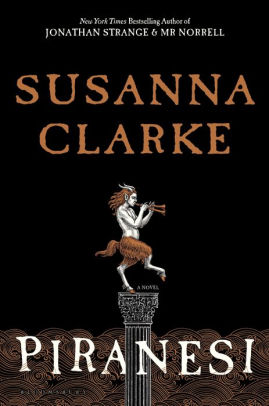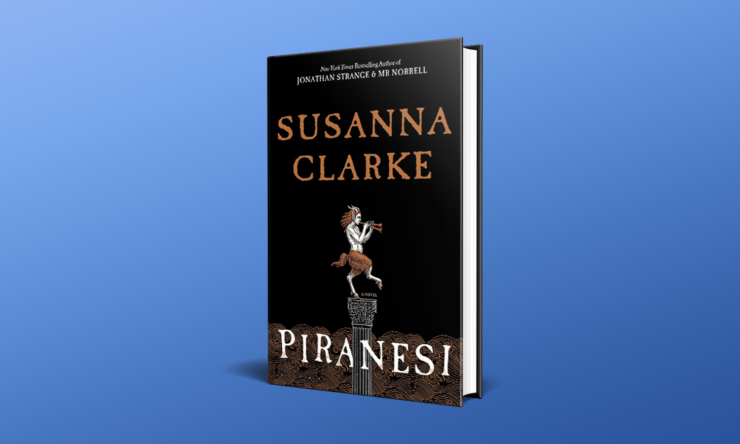We’re thrilled to share an excerpt from Piranesi, a new novel from Susanna Clarke, the New York Times bestselling author of Jonathan Strange & Mr Norrell. Available from Bloomsbury, Piranesi introduces an astonishing new world, an infinite labyrinth, full of startling images and surreal beauty, haunted by the tides and the clouds.
Piranesi’s house is no ordinary building: its rooms are infinite, its corridors endless, its walls are lined with thousands upon thousands of statues, each one different from all the others. Within the labyrinth of halls an ocean is imprisoned; waves thunder up staircases, rooms are flooded in an instant. But Piranesi is not afraid; he understands the tides as he understands the pattern of the labyrinth itself. He lives to explore the house.
There is one other person in the house-a man called The Other, who visits Piranesi twice a week and asks for help with research into A Great and Secret Knowledge. But as Piranesi explores, evidence emerges of another person, and a terrible truth begins to unravel, revealing a world beyond the one Piranesi has always known.
Chapter 3
A list of all the people who have ever lived and what is known of them
Entry for the Tenth Day of the Fifth Month in the Year the Albatross came to the South-Western Halls
Since the World began it is certain that there have existed fifteen people. Possibly there have been more; but I am a scientist and must proceed according to the evidence. Of the fifteen people whose existence is verifiable, only Myself and the Other are now living.
I will now name the fifteen people and give, where relevant, their positions.
First Person: Myself
I believe that I am between thirty and thirty-five years of age. I am approximately 1.83 metres tall and of a slender build.
Second Person: The Other
I estimate the Other’s age to be between fifty and sixty. He is approximately 1.88 metres tall and, like me, of a slender build. He is strong and fit for his age. His skin is a pale olive colour. His short hair and moustache are dark brown. He has a beard that is greying; almost white, it is neatly trimmed and slightly pointed. The bones of his skull are particularly fine with high, aristocratic cheekbones and a tall, impressive forehead. The overall impression he gives is of a friendly but slightly austere person devoted to the life of the intellect.
Buy the Book


Piranesi
He is a scientist like me and the only other living human being, so naturally I value his friendship highly.
The Other believes that there is a Great and Secret Knowledge hidden somewhere in the World that will grant us enormous powers once we have discovered it. What this Knowledge consists of he is not entirely sure, but at various times he has suggested that it might include the following:
- vanquishing Death and becoming immortal
- learning by a process of telepathy what other people are thinking
- transforming ourselves into eagles and flying through the Air
- transforming ourselves into fish and swimming through the Tides
- moving objects using only our thoughts
- snuffing out and reigniting the Sun and Stars
- dominating lesser intellects and bending them to our will
The Other and I are searching diligently for this Knowledge. We meet twice a week (on Tuesdays and Fridays) to discuss our work. The Other organises his time meticulously and never permits our meetings to last longer than one hour.
If he requires my presence at other times, he calls out ‘Piranesi!’ until I come.
Piranesi. It is what he calls me.
Which is strange because as far as I remember it is not my name.
Third Person: The Biscuit-Box Man
The Biscuit-Box Man is a skeleton that resides in an Empty Niche in the Third North-Western Hall. The bones have been ordered in a particular way: long ones of a similar size have been collected and tied together with twine made from seaweed. To the right is placed the skull and to the left is a biscuit box containing all the small bones – finger bones, toe bones, vertebrae etc. The biscuit box is red. It has a picture of biscuits and bears the legend, Huntley Palmers and Family Circle.
When I first discovered the Biscuit-Box Man, the seaweed twine had dried up and fallen apart and he had become rather untidy. I made new twine from fish leather and tied up his bundles of bones again. Now he is in good order once more.
Fourth Person: The Concealed Person
One day three years ago I climbed the Staircase in the Thirteenth Vestibule. Finding that the Clouds had departed from that Region of the Upper Halls and that they were bright, clear and filled with Sunlight, I determined to explore further. In one of the Halls (the one positioned directly above the Eighteenth North-Eastern Hall) I found a half-collapsed skeleton wedged in a narrow space between a Plinth and the Wall. From the current disposition of the bones I believe it was originally in a sitting position with the knees drawn up to the chin. I have been unable to learn the gender. If I took the bones out to examine them, I could never get them back in again.
Persons Five to Fourteen: The People of the Alcove
The People of the Alcove are all skeletal. Their bones are laid side by side on an Empty Plinth in the Northernmost Alcove of the Fourteenth South-Western Hall.
I have tentatively identified three skeletons as female and three as male, and there are four whose gender I cannot determine with any certainty. One of these I have named the Fish-Leather Man. The skeleton of the Fish-Leather Man is incomplete and many of the bones are much worn away by the Tides. Some are scarcely more than little pebbles of bone. There are small holes bored in the ends of some of them and fragments of fish leather. From this I draw several conclusions:
- The skeleton of the Fish-Leather Man is older than the others
- The skeleton of the Fish-Leather Man was once displayed differently, its bones threaded together with thongs of fish leather, but over time the leather decayed
- The people who came after the Fish-Leather Man (presumably the People of the Alcove) held human life in such reverence that they patiently collected his bones and laid him with their own dead
Question: when I feel myself about to die, ought I to go and lie down with the People of the Alcove? There is, I estimate, space for four more adults. Though I am a young man and the day of my Death is (I hope) some way off, I have given this matter some thought.
Another skeleton lies next to the People of the Alcove (though this does not count as one of the people who have lived). It is the remains of a creature approximately 50 centimetres long and with a tail the same length as its body. I have compared the bones to the different kinds of Creatures that are portrayed in the Statues and believe them to belong to a monkey. I have never seen a live monkey in the House.
The Fifteenth Person: The Folded-Up Child
The Folded-Up Child is a skeleton. I believe it to be female and approximately seven years of age. She is posed on an Empty Plinth in the Sixth South-Eastern Hall. Her knees are drawn up to her chin, her arms clasp her knees, her head is bowed down. There is a necklace of coral beads and fishbones around her neck.
I have given a great deal of thought to this child’s relationship to me. There are living in the World (as I have already explained) only Myself and the Other; and we are both male. How will the World have an Inhabitant when we are dead? It is my belief that the World (or, if you will, the House, since the two are for all practical purposes identical) wishes an Inhabitant for Itself to be a witness to its Beauty and the recipient of its Mercies. I have postulated that the House intended the Folded-Up Child to be my Wife, only something happened to prevent it. Ever since I had this thought it has seemed only right to share with her what I have.
I visit all the Dead, but particularly the Folded-Up Child. I bring them food, water and water lilies from the Drowned Halls. I speak to them, telling them what I have been doing and I describe any Wonders that I have seen in the House. In this way they know that they are not alone.
Only I do this. The Other does not. As far as I know he has no religious practices.
The Sixteenth Person
And You. Who are You? Who is it that I am writing for? Are You a traveller who has cheated Tides and crossed Broken Floors and Derelict Stairs to reach these Halls? Or are You perhaps someone who inhabits my own Halls long after I am dead?
Excerpted from Piranesi by Susanna Clarke, copyright © 2020. Published by Bloomsbury USA










